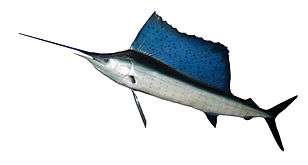Sailfish
| Sailfish Temporal range: 59–0 Ma | |
|---|---|
 | |
| Scientific classification | |
| Kingdom: | Animalia |
| Phylum: | Chordata |
| Class: | Actinopterygii |
| Order: | Perciformes |
| Family: | Istiophoridae |
| Genus: | Istiophorus Lacépède, 1801 |
| Species | |
| |
| Synonyms | |
| |
Sailfish are a genus Istiophorus of billfish living in warmer sections of all the oceans of the world. They are predominantly blue to gray in colour and have a characteristic erectile dorsal fin known as a sail, which often stretches the entire length of the back. Another notable characteristic is the elongated bill, resembling that of the swordfish and other marlins. They are therefore described as billfish in sport-fishing circles.
Species
Two sailfish species have been recognized.[2][3] No differences have been found in mtDNA, morphometrics or meristics between the two supposed species and most authorities now only recognized a single species, (Istiophorus platypterus), found in warmer oceans around the world.[3][4][5][6] FishBase continues to recognize two species:[2]
- Atlantic sailfish (Istiophorus albicans).
- Indo-Pacific sailfish (Istiophorus platypterus).
Description

Sailfish grow quickly, reaching 1.2–1.5 m (3 ft 11 in–4 ft 11 in) in length in a single year, and feed on the surface or at middle depths on smaller pelagic forage fish and squid. Individuals have been clocked at speeds up to 110 km/h (68 mph), which is one of the highest speeds reliably reported in any water organism.[3][7] Generally, sailfish do not grow to more than 3 m (9.8 ft) in length and rarely weigh over 90 kg (200 lb).
The sail is normally kept folded down and to the side when swimming, but it may be raised when the sailfish feels threatened or excited, making the fish appear much larger than it actually is. This tactic has also been observed during feeding, when a group of sailfish use their sails to "herd" a school of fish or squid.

Sailfish are highly prized game fish, and are known for their incredible jumps and great speed. They can swim 100 m in 4.8 sec. They can appear in a startling array of colours, from subdued browns and grays to vibrant purples and even silver. Their body colours are often highlighted by stripes of iridescent blue and silver dots. Sailfish can change their colours almost instantly—a change controlled by their nervous system. The sailfish can rapidly turn its body light blue with yellowish stripes when excited, confusing its prey and making capture easier, while signalling its intentions to fellow sailfish.[8]
Timeline

References
- ↑ "A compendium of fossil marine animal genera". Bulletins of American Paleontology. 364: 560. 2002. Retrieved 2008-01-08.
- 1 2 Froese, Rainer, and Daniel Pauly, eds. (2013). Species of Istiophorus in FishBase. April 2013 version.
- 1 2 3 McGrouther, M. (2013). Sailfish, Istiophorus platypterus. Australian Museum. Retrieved 26 April 2013.
- ↑ Collette, B.; Acero, A.; Amorim, A.F.; Boustany, A.; Canales Ramirez, C.; Cardenas, G.; Carpenter, K.E.; de Oliveira Leite Jr., N.; Di Natale, A.; Die, D.; et al. (2011). "Istiophorus platypterus". IUCN Red List of Threatened Species. Version 2012.2. International Union for Conservation of Nature. Retrieved 26 April 2013.
- ↑ Gardieff, S: Sailfish. Florida Museum of Natural History. Retrieved 26 April 2013.
- ↑ Collette, B.B., McDowell, J.R. and Graves, J.E. (2006). Phylogeny of Recent billfishes (Xiphioidei). Bull. Mar. Sci. 79(3): 455-468.
- ↑ Haulin' Bass - elasmo-research.org. Accessed March 19, 2008
- ↑ National Geographic Society
- Schultz, Ken (2003) Ken Schultz's Field Guide to Saltwater Fish pp. 162–163, John Wiley & Sons. ISBN 9780471449959.
External links
| Wikimedia Commons has media related to Istiophorus. |